Landscape books often write about shade as a “problem”, or give chapters on “solutions” for shady locations. I think that’s crazy talk.
Shade plantings require a slightly different mindset, like stepping two feet to the left and looking at the world slightly skewed. Full sun is luxuriant-throw anything in there, and it’s bound to look good. How can you go wrong with something in bloom? But shade draws a sharper line, and making dark locations look good without relying on a full palette of blooming plants requires looking at other properties of your plants, things gardeners and landscapers take for granted in the light of day. Master planting in the shade, and the required skills will make your sun plantings all that more rich and interesting.
Like the color green. You know green, it’s all that stuff beneath the blooms on your Coneflower. Green is a color too, and without the laziness of the myriad of colors of flowers to rely upon, shade draws out an appreciation of the multiple hues of greeen. Or how about texture? Think of the huge leaves of hosta, and play that against a finely textured grass. It’s about making the plants talk about what they are for the entire season, not just the couple of weeks they are in bloom.
I bring all of this up because of one of my favorite landscape jobs this year, maybe of my entire 4+ years here so far. The service building doesn’t have a glorious name (how could it?), and the north side had an overgrown thicket of juniper, hating life in the shade, and Bayberry, a nice plant prone to suckering from the roots to over-fill any area given it. Yearly our department was asked to rediscover the sidewalk leading up to the main door, as the shrubbery in the beds nearby were eating any free space the path may have had. Once again I failed at a before picture. I actually took one this time, and deleted it by accident from my cell phone. Trust me, it was a jungle.

Here’s the after picture. All of what you see was a thicket, including the grass now on the left side underneath the White Pine. The large tree on the left is a Red Maple, which strangely enough turns a bright yellow every fall, instead of the Red of it’s name. They do that sometimes. The bench by the door was already there, and frequently used by my wife on her breaks from the Grille working the night shift, so that was staying. (And I would have gotten to this landscape eventually anyway, but having her out there a lot certainly did move it up on my priority list. Work until 3 in the morning, I figure you deserve a nice garden to relax in…)
This was also the first landscape job where I got to work with Brad Lambert, our resident mason in facilities. Really nice guy, and more than willing to put up with my crazy ideas. The landscape had a BFR for no known reason right at the end of the walk to the front door, and, rather than move it, we decided to build a small stone wall off from it, and we put a dwarf Weeping Hemlock (‘Cole’s Prostrate’) right at the top to cascade off of the new wall. Less work to build the wall then move the 500 pound rock out of the way.
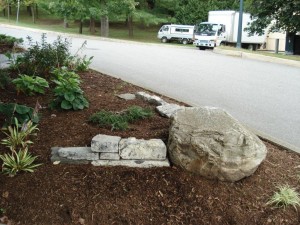
Brad and I were having fun, so he stuck around and made a stone path through part of the garden. Someone stopped by, probably going upstairs to Human Resources, and leaned their bike against the wall, so a bike rack seemed in order.
We had a little extra stone, so Brad jazzed up the bench some too.
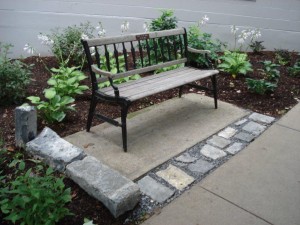
The stone is Panton stone, originally used as the low wall around the deck at Proctor, and we stole recycled it from storage.
Other woody plants in there include an Upright Yew, in an attempt to screen the parking lot from the front door, and some “Landmark” Rhododendron, another great shade evergreen with red flowers in the early spring. I haven’t planted this one before, but I’ve had good luck with other small leaved rhodies, so I have hope. There is also dwarf Japanese Golden Yew, Taxus cuspidata ‘Nana Aurescens’. This plant stays gold all winter long, adding some nice color near the walkway.
We left a woody plant in there, tucked behind the bench. I don’t even recognize it when I first started working at Middlebury-it’s not really supposed to live this far north.
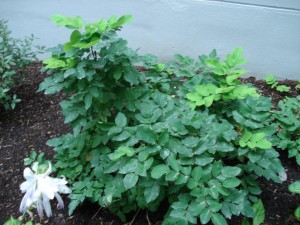
Oregon Grape Holly, Mahonia aquifolium, is a solid Zone 5 plant, though some people say Zone 4 with protection, which this location certainly has. Native to the west coast, this Barberry cousin has chains of yellow blooms in the early spring (the state flower of Oregon no less), and purple grape shaped fruit in the fall. Edible, you can make jam from it, but I wonder if it’s one of those fruits that needs copious white sugar to make it palatable. The evergreen leaves are shaped like holly, and are used as such by florists.
The plant fun I had here, though, was in the perennials. Hostas are the backbone, their thick large leaves giving a coarse texture to play off of in the rest of the garden. Current plant breeding has given the hosta genus much more interest than the old fashioned green and white leaf with purple flowers your grandmother ringed all of her trees with back in the 60’s.
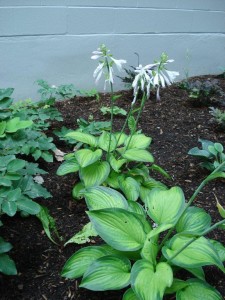
We used ‘Guacamole, an apple green and gold leaf with large white flowers late in the summer, scenting the air with a jasmine fragrance, along with my favorite scented Hosta, ‘Royal Standard’. ‘Cherry Berry’ is another hosta, put next to the pathway, with spear shaped gold and green leaves, but really planted for their dark purple blooms, followed by masses of little red seeds, hence the name.
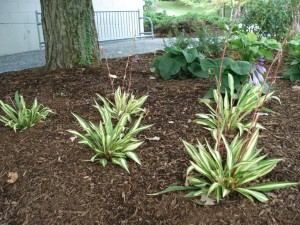
Another hosta, massed underneath the memorial Red Horsechestnut at the end of the bed is ‘Gold Standard’, once again with gold and green leaves. This is the same hosta we planted underneath the giant Sycamore at the Deanery on College Street.
Other plants are sprinkled in there as well, included a cool variegated Carex, ‘Evergold’, and some red leaved Snakeroot, Cimicifuga ‘Hillside Black Beauty’. We also stuck in some Heuchera, a new cultivar called ‘Mocha’, and a great Japanese Painted Fern named ‘Ghost’. We didn’t forget about spring, sticking in a perennial Forget me Not with the strange latin name of Brunnera, a.k.a. Siberian Bugloss. The forget me not everybody knows is Myosotis, but that’s a biennial, and hard to manage in commericial landscapes (it gets weeded and pulled quite a bit) The Siberian Bugloss has large dark leaves like a hosta, and seemingly live forever.
My favorite shade plant is next to the walkway-it’s small blooms in the fall need to be seen closely. And once you’ve looked, you’re hooked. Tiny speckled purple blooms like tiny orchids cover the plant all fall. The name, though, is unfortunate-Toad Lily. Let’s go all Latin on it, though, and call it Tricyrtis. The speckles on the blooms and leaves may make it look like a toad, but that’s rather silly. Native to Eastern Asia, from Nepal to Japan, even to the Philippines. Tricyrtis is in the Lily family, and needs shade to thrive in the south, but this far north does fine in quite a bit of sun, given proper moisture. It is only hardy to Zone 5, but I’d try it elsewhere, given sufficent snow cover. The cultivar we used is ‘Gilt Edge’, featuring gold ringed leaves all summer long.
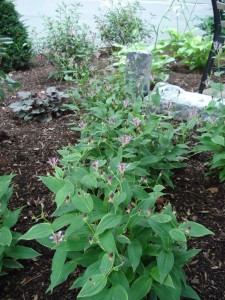

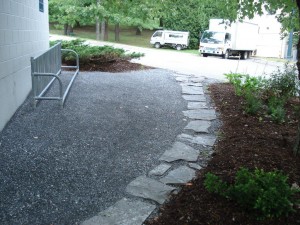
Such a beautiful job! Your wife must be very pleased 🙂
Love the stone work — nice way to work with the BFR 😉